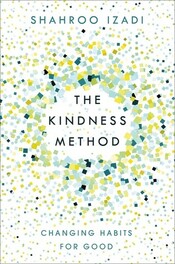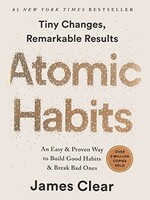
The Kindness Method - Book Summary
Changing Habits for Good Using Self-Compassion and Understanding
In this episode of 20 Minute Books, we dive into "The Kindness Method" by Shahroo Izadi, a guide that illuminates the power of self-compassion in habit formation and personal change. Published in 2019, this transformative book offers a refreshing approach to tackling challenges such as addiction, weight loss, and professional development.
Drawing on her rich background as a Behavioral Change Specialist and relapse prevention coach, Shahroo Izadi articulates strategies that merge her professional findings with heartfelt personal insights. As she guides readers through practical exercises, Izadi emphasizes the significance of treating oneself with kindness and understanding.
"The Kindness Method" is particularly suited for individuals aiming to conquer drug or alcohol addiction, those seeking sustainable weight loss solutions, and professionals pursuing pivotal career changes. Additionally, Shahroo Izadi's methodologies have captivated audiences far and wide, with her workshops frequently selling out and her insights being featured across notable platforms, including BBC Radio 1 and The Telegraph.
Join us as we explore how cultivating a compassionate self-view can fundamentally alter the way we approach personal hurdles and strive toward lasting change.
Why is lasting change so elusive?
Have you ever set ambitious goals to alter a habit, only to find yourself slipping back into old patterns? Perhaps you've aimed to cut down on your caffeinated splurges, or dreamed of embarking on a new career path, yet years later, you find yourself in the same routines. Despite our best efforts and the plethora of resources at our fingertips — from transformative self-help manuals to expert-led health programs — maintaining change remains a pervasive challenge.
Discover the power of self-compassion for enduring transformation.
This discussion offers a fresh perspective on how to effectively address behavioral change, emphasizing the importance of self-compassion and understanding. Through straightforward exercises, you will learn to dismantle longstanding habits and lay down the foundations for sustainable new practices.
Throughout this exploration, you will uncover:
- The reasons why tagging your old habits as "bad" might actually hinder your progress.
- The commonalities shared by those who have successfully implemented and sustained behavioral changes.
- Valuable lessons from addiction therapy that can be applied to any form of behavioral modification.
By embracing self-compassion, you not only enhance your resilience when facing setbacks but also increase your chances of achieving and maintaining positive life changes.
Discovering the root of change through self-compassion
Shahroo Izadi had become an expert at losing weight — through countless diets, health retreats, and sessions with weight loss coaches. Yet, she struggled relentlessly with maintaining her weight loss. Each time the scale showed an increase, she would oscillate between extreme dieting and excessive eating, punishing herself for her failures and isolating herself socially until she felt "worthy" again. But the happiness she sought from reaching her goal weight was always fleeting, just out of reach.
This cycle continued until Shahroo stumbled upon a life-altering realization: perhaps her real battle wasn't with her weight, but with her self-esteem.
This brings us to a profound insight: Self-compassion is essential for sustainable change.
Following a particularly painful breakup, which led to a significant weight gain, Shahroo's self-esteem plummeted yet again, driving her into the familiar arms of extreme dieting and rigorous exercise. It was during this phase she consulted a counselor who challenged her perspective with a startling question: "What would happen if you never lost the weight?"
Initially, this question sparked anger. How could she possibly be content without achieving her ideal weight? However, as days passed, Shahroo observed others who were overweight and realized she didn't think any less of them for their size. Why then was she so harsh on herself?
Emboldened by this new perspective, Shahroo decided to experiment. She resolved to treat herself with the compassion she would extend to her future, slimmer self, regardless of her current weight. This approach, radically different from her previous methods, involved fostering kindness towards herself, even on days she fell short of her dietary goals.
To her astonishment, this mentality not only accelerated her weight loss but also positively transformed other areas of her life. Self-compassion, it turned out, was not just about being kind to oneself in the context of weight loss but was crucial in nurturing a holistic well-being and instigating lasting change.
Embrace a judgment-free zone for effective change
During her tenure as a therapist within the realm of addiction recovery, Shahroo Izadi once received a thought-provoking call from a friend. This friend was concerning herself with the fact that her partner, a recovering alcoholic of many years, still frequented daily support-group meetings. For Shahroo, the situation was clear: continual engagement in recovery activities signified not just stability but a commendable level of self-awareness and coping proficiency, traits that far exceeded those of average individuals trying to break or form habits.
This leads us to a crucial understanding: enduring change necessitates a judgment-free approach.
Shahroo's experiences, particularly those working in addiction recovery, enriched her view on how similar techniques can be extrapolated to any form of behavioral modification. A significant insight for her was during a presentation on the dark web where she learned that alongside its notorious markets for illicit substances, the dark web also hosted communities where individuals grappling with addictions anonymously exchanged coping strategies. These forums, importantly, were places devoid of judgment.
In stark contrast, the protocol at substance misuse treatment facilities in the UK typically includes critical procedural steps like filling out consent forms for potential information sharing with social services or law enforcement. Clients may need to disclose sensitive details such as their parental status, criminal records, and mental health conditions. This can pose a severe barrier; for instance, an alcohol-dependent mother seeking help risks her parental rights if she fully discloses the scope of her issues. Without the freedom to speak openly, obtaining necessary support becomes significantly complicated.
The principle of a judgment-free process isn't limited to addiction; it applies universally across various types of behavioral change. Shahroo herself realized that earlier in her life, she wouldn't have confessed to her doctor that her motivation for losing weight was more about looking good in a swimsuit than preventing diabetes.
Recognizing this, when engaging in self-reflection exercises from this narrative, the creation of a completely candid environment is vital. You might find it helpful to use a private notebook reserved solely for these reflections, ensuring it's kept in a place away from prying eyes. Such a safe, uninhibited space paves the way for more profound honesty and, consequently, more meaningful change.
Celebrate your strengths and past successes
Embarking on a journey to change aspects of your own behavior can sometimes feel like an uphill battle. Motivation seems plentiful at the outset, but without a solid framework to sustain it, this enthusiasm often wanes, leading us to abandon our goals. What's even more disheartening, repeated failures can make us believe that change is beyond our reach.
Yet, it’s important to remember that each of us already holds within ourselves a record of positive traits and achievements that testify to our ability to succeed. During those moments when doubt creeps in, recalling these can be incredibly empowering. This is where the Kindness Method shifts the focus, advocating the celebration of what you've already achieved to foster self-compassion before tackling new changes.
Here is the essence: Map out your positive qualities and accomplishments.
To truly embed lasting changes, starting with a clear and structured approach is crucial. Part of this process involves creating visual representations or 'maps' to appreciate your current strengths and visualize your goals.
Begin with a map highlighting your positive attributes. On a sheet of paper, at the center, write "Ways I’m Happy to Be" and encircle it. Around this circle, enumerate the qualities that define you positively: perhaps constructive feedback you've cherished, moments where you've demonstrated kindness, or attributes that make you a valued friend, spouse, or parent. For each trait, draw a circle connected back to the central idea, creating a wheel-like diagram.
Next, craft a "What I’m Proud Of" map. Here, list achievements that fill you with pride—be it a physical challenge you've overcome, professional milestones, or personal relationships you’ve nurtured. Keep adding to this map as you accomplish more and recognize new qualities in yourself.
By continuously populating these maps, you shift your focus from perceived limitations to a more holistic, affirmative view of yourself. This reflective practice not only enhances self-esteem but gradually builds a resilient mindset conducive to sustainable change.
Learn from the past to craft your future success
Change is a personalized journey; what suits one individual might barely scratch the surface for another. This insight resonated deeply with Shahroo Izadi, who noticed a common thread among her most successful clients: a commitment to introspection. They invested time in identifying their unique behavioral patterns, which in turn allowed them to develop tailored strategies that supported lasting achievements.
This leads us to an insightful perspective: pinpoint what has worked and what hasn't in your past endeavors.
To begin, reflect on a past challenge you conquered, where hard work, dedication, or perseverance was key. Title this analysis “When I’m in the Zone.” Examine the elements that contributed to your success. Were there specific conditions, such as your environment, support system, or personal habits like maintaining hydration or adhering to a structured routine, that facilitated your accomplishments?
After mapping out these conducive factors, take a moment to review and identify any recurring themes that could indicate optimal conditions for future successes.
It's equally crucial to address the flip side with a “What Hasn’t Worked” map. This tool is designed to document the barriers you encountered in previous attempts at change. Look back at these instances and dissect the factors that didn’t align with your needs or goals. Was it misalignment with your personality, external disruptions, or perhaps a lack of self-belief that hindered your progress? For example, a juice cleanse might not have yielded the desired weight loss results, or perhaps dependency on external motivation proved unsustainable.
Completing this exercise may recall past failures, but don't let this dishearten you. Recognizing what hasn't worked is foundational in readying yourself for future achievement. By assimilating both positive drivers and hindrances from your past, you equip yourself with a balanced blueprint for effective and personalized change strategies, setting the stage for sustained success in your next endeavors.
Understanding the roots of your habits for effective change
Many of us have habits we'd like to change or eliminate. Often, these habits are labeled as "bad," yet it's essential to recognize that at some point, these patterns served a purpose in our lives. Take, for instance, the common habit of social drinking, which many people engage in to feel more at ease in social environments.
Labeling these habits as "bad" tends to fuel a cycle of self-criticism that undermines our attempts to change. It's more constructive to view these behaviors within the broader context of our lives and personal development.
This brings us to an essential step: Identifying the habits you want to change and understanding how they came to be.
Begin by mapping out the adverse effects of the habit you wish to alter. Title this visual "What’s the Harm?" Draft a central bubble on your page and branch out to list the negative impacts you've noticed. You might discover that this habit influences more aspects of your life than you initially thought.
For example, Shahroo had a client who struggled with recreational cocaine use, primarily on weekends. The client wasn’t primarily concerned about the legality of her actions, but rather the debilitating anxiety, intense sugar cravings, and deep-seated self-doubt that ensued after each session. This vicious cycle prevented her from addressing her underlying emotional issues, as she'd simply resume using the next weekend as an escape.
By meticulously identifying and outlining how her habit detrimentally affected her life, the client found a renewed motivation to reduce and eventually cease her drug use. Reminding herself of the undesirable aftermath enabled her to resist the lure of nightlife escapades.
Once you've established the negative impacts, delve into the origins of these habits with a "Why Haven’t I Changed Already?" map. Investigate and jot down the specific reasons keeping you entrenched in these behaviors. Does the habit provide an escape from stress, akin to Shahroo’s client? Or is it a behavior so ingrained that it feels like part of your identity?
Being truthful in this exploration allows for self-forgiveness regarding past stagnations and paves the way for compassionate and sustainable progression. By understanding both the consequential harms and the roots of your habits, you set a well-informed foundation for meaningful change.
Navigate challenges by pinpointing and managing your triggers
Previously, we've discussed the importance of recognizing what strategies have and haven't worked in past efforts to change behavior. Beyond internal factors, it’s crucial to identify external triggers—those conditions or scenarios that sway you from your path of change.
Everyone has specific triggers—be it stress, hunger, or emotional strains from personal or professional areas. Regardless of the nature of these stressors, be it financial worries, looming deadlines, or relationship pressures, remember, the perfect moment for transformation simply does not exist. However, by identifying these triggers early, you can develop coping mechanisms that not only enhance your daily resilience but also fortify your long-term commitment to change.
Here's the central insight: Tracking your triggers is a proactive step towards mastering them.
Begin by creating a “What Will Test Me?” map. On this map, jot down various stressors, worries, or situations you anticipate could derail your progress. These could range from starting new relationships, to traveling, to encountering social situations that previously encouraged undesirable habits.
For some, the mere thought of needing guidance in areas others navigate effortlessly is enough to dampen spirits. For others, early successes might breed complacency, leading them to believe prematurely that they have conquered their challenges.
As you review your trigger map, think about strategies to mitigate these triggers before they pose a threat. For instance, if your goal is to quit smoking, consider steering clear of smoking areas or gatherings where friends smoke, especially in the initial phases of your quitting process.
Additionally, maintaining a daily journal can play a crucial role in managing your triggers. Each morning, spend a few minutes outlining potential challenges and strategize your responses. This practice equips you mentally, positioning you to handle situations assertively as they arise throughout the day. In the evening, reflect on your day's responses and note any unexpected triggers, updating your “What Will Test Me?” map accordingly.
By actively monitoring and adjusting to your trigger environments, you not only prevent lapses but also nurture a consistently proactive approach towards sustaining your behavioral changes.
Building a path to success with structured, realistic goals
After meticulously analyzing your current state, aspirations, and potential hurdles through detailed mapping, the next critical step is to devise a structured action plan. This requires setting practical, phased goals and integrating regular review points to monitor your progress and refine your strategies accordingly. To begin, you might consider establishing a reminder to evaluate your achievements every three weeks.
The essence of this approach is to create a realistic plan with incremental goals.
Often, we are tempted to adopt drastic measures to achieve our aims quickly. Take the case of Shahroo's client, Paul, who was desperate to find a more fulfilling job. After spending years in a stagnant position, his daily routine had become a cycle of work, evening drinks at the pub with colleagues, and complaining about workplace grievances. This lifestyle left him hungover and unmotivated, further impacting his eating habits and professional dissatisfaction.
Paul initially proposed a radical overhaul: completely quit drinking, embrace a strict diet, hit the gym daily, and dedicate several hours each night to job searching. However, Shahroo advised a more moderate approach. She suggested that Paul start by choosing two pub-free evenings per week to focus on job applications. These nights would also include preparing a nutritious meal he enjoyed and walking part of the way to work the following morning. This balanced plan was designed to foster gradual improvement without overwhelming Paul.
Adopting a realistic plan with manageable steps increases the likelihood of success. Each achievement, no matter how small, builds confidence and motivates further effort. On your scheduled review dates, add your accomplishments to your “What I’m Proud of” map and identify new, small challenges that will advance you toward your ultimate goals. By doing so, you create a cycle of positive reinforcement and continuous progress, paving the way towards the lifestyle you desire.
Embracing Change with Self-Compassion
The essence of these insights is that fostering positive habits through self-compassion significantly enhances our lives, transcending the immediate objectives we often set for ourselves. By diligently charting your current position, desired destination, and constructing a feasible plan, you enhance your likelihood of sustained success. This strategic approach enables you to navigate setbacks gracefully and stay aligned with your long-term goals. Emphasizing self-compassion throughout this process not only facilitates growth but also fortifies resilience, turning the journey of self-improvement into a more fulfilling and achievable endeavor.






